How to Vixie? Make a Vertical Double Half-Hitch knot?
Unlock the art of macramé with my step-by-step guide on how to make the Vertical Double Half-Hitch knot! Whether you’re a seasoned crafter or just starting your fiber adventure, this essential knot will add structure and elegance to your projects. Dive into the world of intricate patterns and bold designs as we walk you through each move with clear, professional instructions. Ready to elevate your macramé skills and create stunning, textured pieces? Let’s get knotting!
KNOTS TUTORIALS
Vixie Macrame
6/22/20255 min read

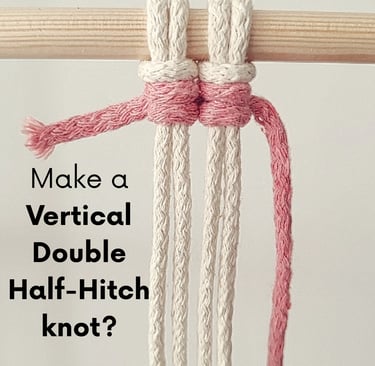
The Vertical Double Half-Hitch knot is a versatile and sturdy stitch essential for creating clean, vertical lines in macrame projects. This knot involves tying 2 Half-Hitches consecutively around a holding cord to build precise patterns and add texture to your work. Mastering this knot will expand your ability to craft intricate designs with control.
You’ll use a working cord to wrap around one or more anchor cords, which stay straight and act as the framework. Unlike simple Half-Hitches, the Vertical Double version offers stronger grip and better shape retention, making it ideal for wall hangings and decorative elements. Learning this technique enhances both the strength and aesthetics of your macrame pieces.
This tutorial breaks down the steps into manageable actions, helping you build confidence in tying the knot correctly. With practice, you’ll add a reliable skill to your macrame toolkit that supports a wide range of creative patterns and textures.
What Is the Vertical Double Half-Hitch knot?
The Vertical Double Half-Hitch knot is a staple in macrame used to create clean vertical lines. It involves wrapping a working cord twice around an anchor cord positioned vertically. This structure gives you control over the direction and flow of your design.
Origins and Historical Significance
The Vertical Double Half-Hitch knot belongs to a family of knots with long practical and decorative use in crafts like sailing and climbing. In macrame, it evolved as a favored stitch because it allows precise shaping of patterns, making it essential for advanced designs.
Though its origins trace back to functional knots such as the Clove Hitch, macrame adapted it into an artistic medium. Its name reflects the double wrapping which strengthens the hold and ensures durability. Understanding this history can give you a deeper appreciation when using it in your projects.
Distinguishing Features
This knot is characterized by the anchor cord running vertically, with the working cord wrapping around it twice. This double wrap secures the knot firmly while allowing you to create vertical, horizontal, or diagonal lines depending on your technique.
Unlike simpler knots, the Vertical Double Half-Hitch gives you directional control—you can change the flow of the cords to build patterns or textures. It’s also known as a Vertical Clove Citch, which emphasizes its structural importance. This knot’s versatility makes it fundamental in macrame design.
Why Use the Vertical Double Half-Hitch knot in Macrame?
The Vertical Double Half-Hitch knot provides precise control over the direction of your cords and adds structure to your design. Its versatility makes it suitable for creating defined lines and patterns that enhance your project’s overall look and strength.
Strengths and Applications
This knot forms strong vertical lines by wrapping the working cord twice around a vertically positioned anchor cord. It’s excellent for creating clean, straight edges or geometric patterns in your work. The secure wrapping prevents slipping, making it reliable in large or complex pieces.
You can use it to build vertical textures such as columns or borders, giving your design visual rhythm and balance. It also allows for combining different colors and cord thicknesses while maintaining stability. This knot is efficient for adding detailed accents without bulk.
Comparison to Other Macrame knots
Compared to single Half-Hitch or Square knots, the Vertical Double Half-Hitch knot offers more control over line direction. While Square knots create bulkier, flatter sections, this knot creates thinner, elongated lines ideal for patterns requiring precision.
Unlike the Horizontal or Diagonal versions, the Vertical orientation works best for straight vertical elements, making it less flexible for curves. It requires an anchor cord set vertically, making setup slightly more involved but resulting in cleaner vertical lines. This knot excels where strength and line definition are priorities.
Step-by-Step Tutorial: Tying the Vertical Double Half-Hitch knot
To create the Vertical Double Half-Hitch knot, you need to focus on proper cord arrangement and controlled tension. The knot builds up by adding working cords vertically around the filler cords, so understanding each step ensures neat, consistent results.
STEP 1
Set up a working cord (pink) along with a series of vertical anchor cords (white). Ensure that the working cord passes underneath the 1st anchor cord.
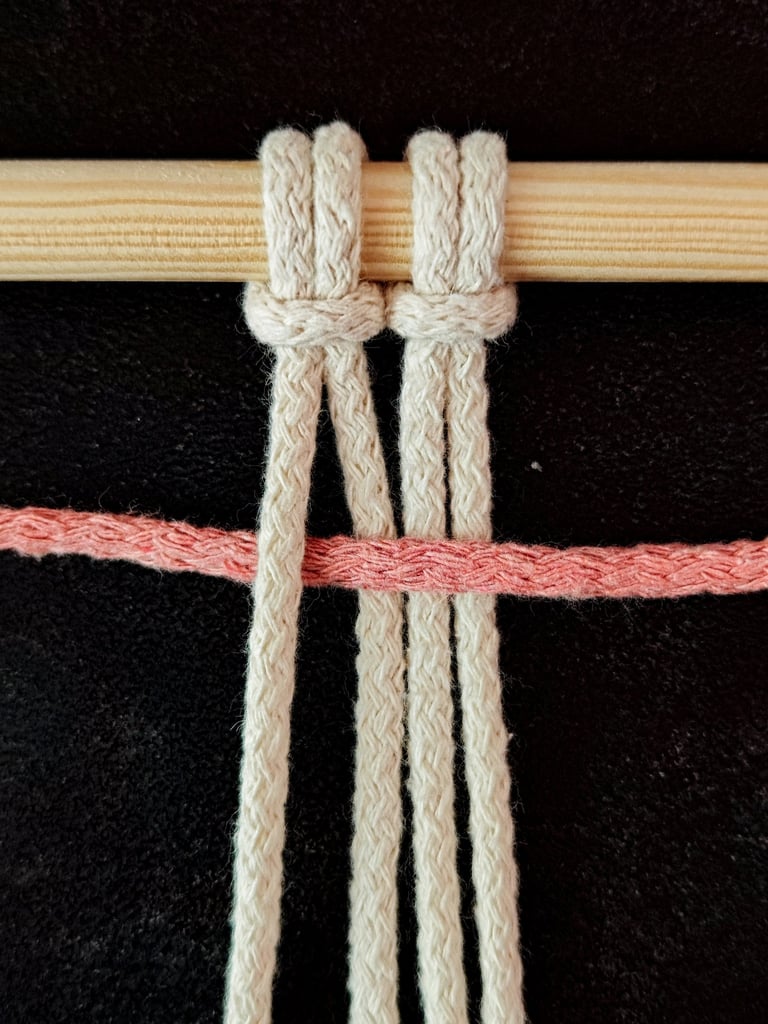

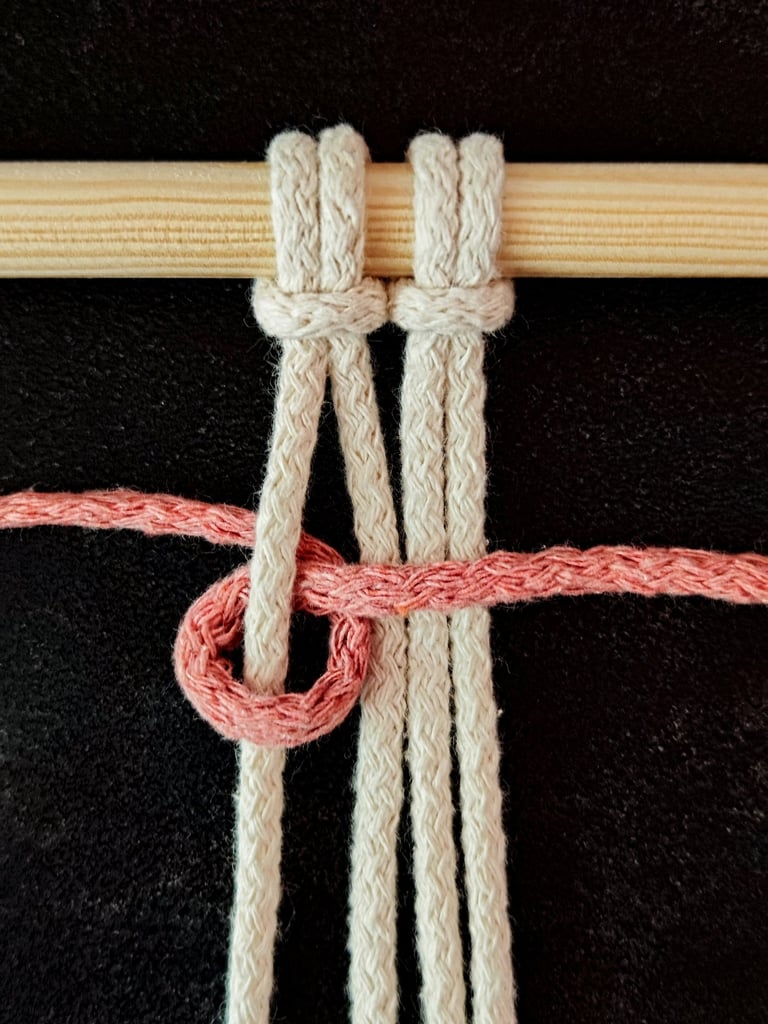

STEP 2
Take the right end of the working cord (pink) and wrap it clockwise around the anchor cord (white). Then, pass it back through the loop you just formed, moving upward.
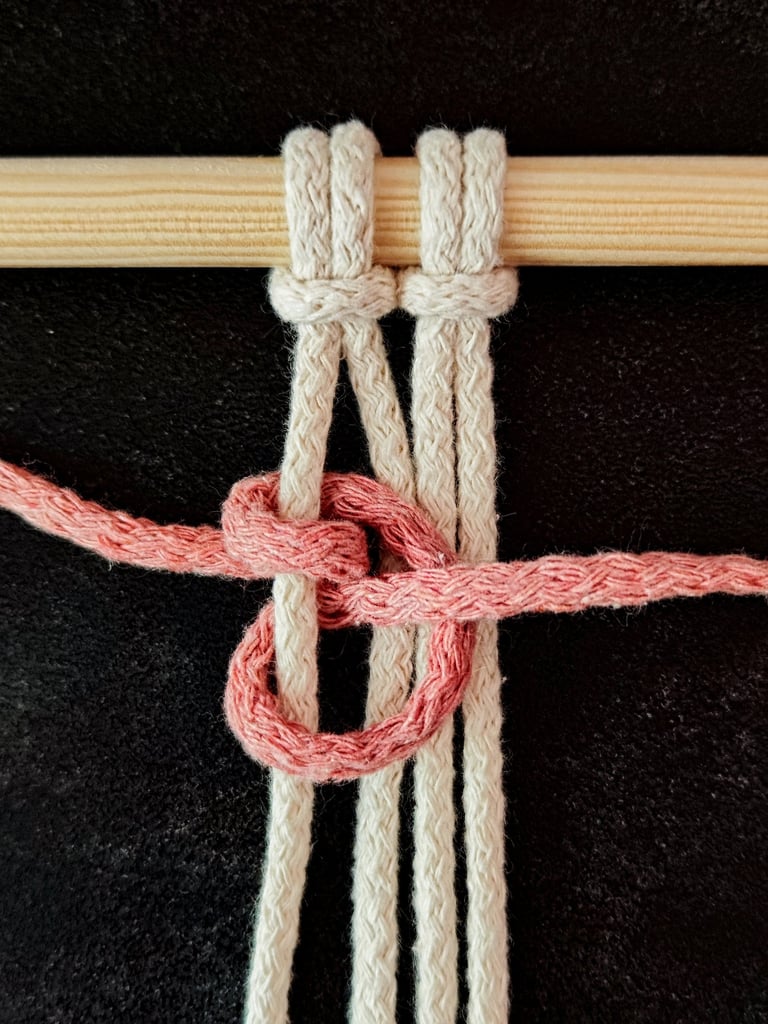

STEP 3
Wrap the working cord clockwise around the anchor cord (white) once more, then pass it back upward through the loop you just created.
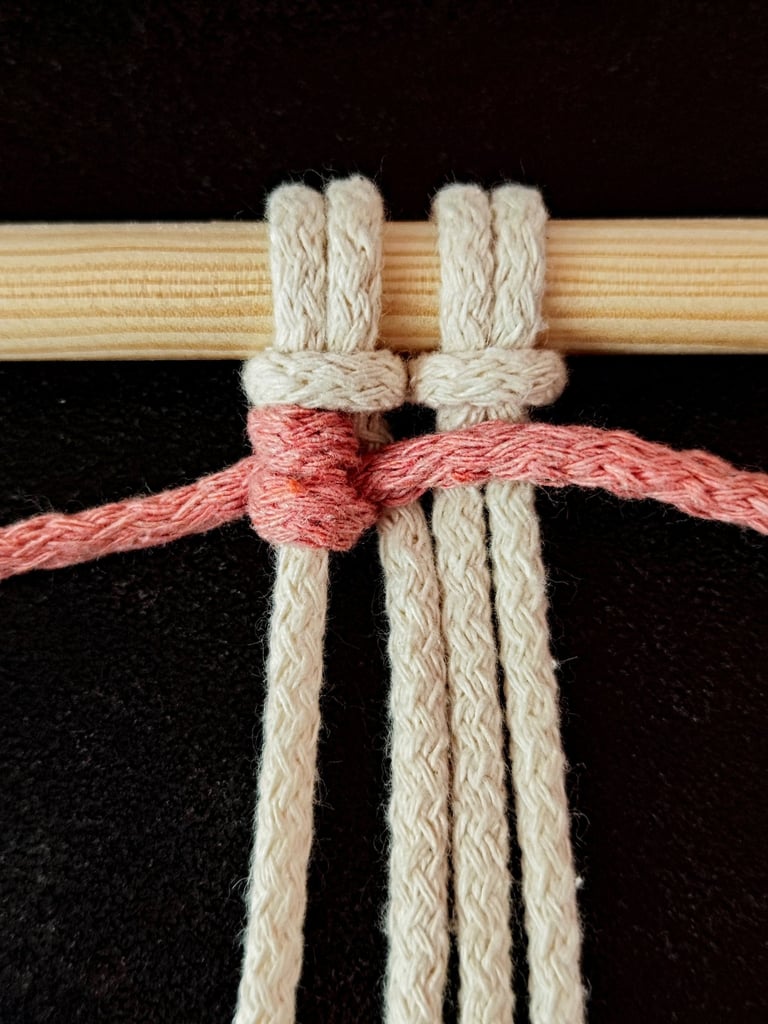

STEP 4
Gently pull both ends of the working cord to tighten the knot securely.
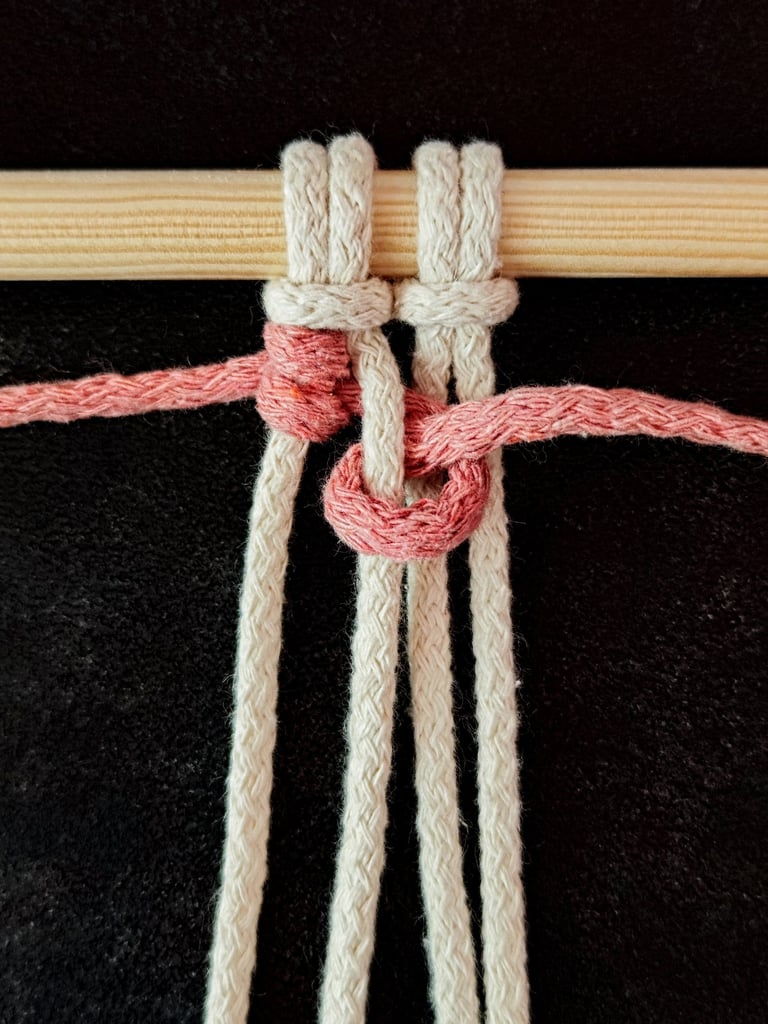

STEP 5
To create a new row, add another anchor cord (white) and repeat the previous steps:
wrap the working cord (pink) clockwise around the new anchor cord, then pass it back upward through the loop you just formed.
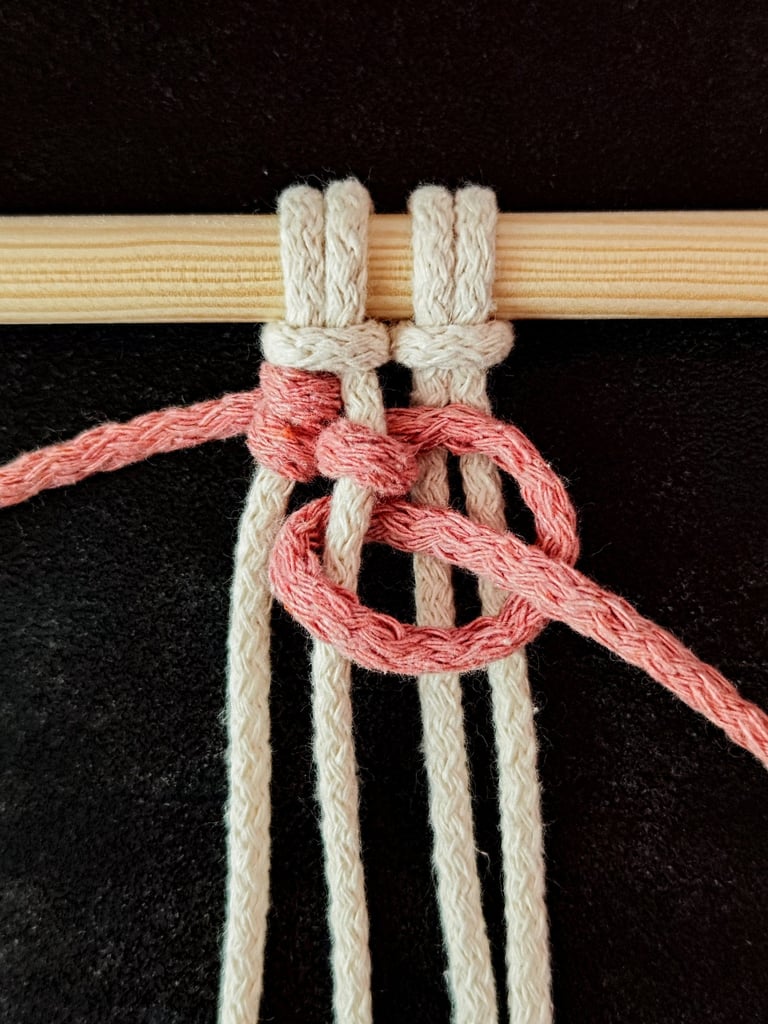

STEP 6
Repeat the process once more:
wrap the working cord (pink) clockwise around the anchor cord (white), then pass it back upward through the loop you just created.
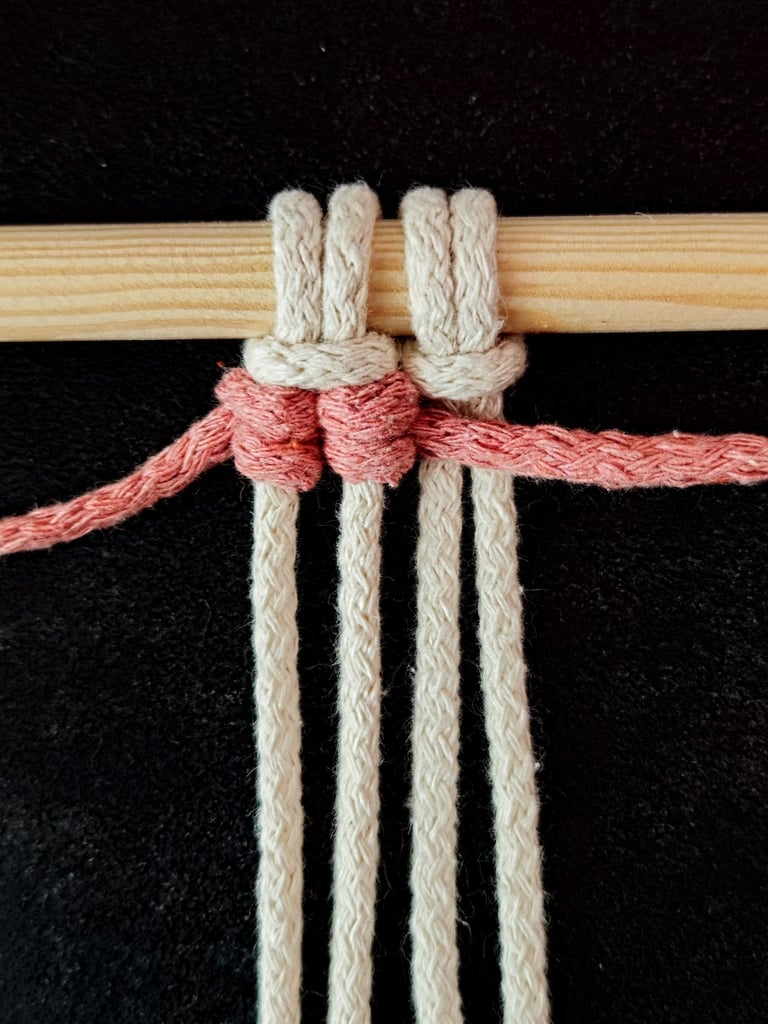

STEP 6
Tighten each knot firmly and evenly to ensure the design appears neat and consistent.
Troubleshooting Common Mistakes
If your knots look loose or uneven, check your working cord tension first. Consistent tension is critical to maintain even spacing and grip.
Avoid twisting the cords, as it can cause the knots to slant or bunch. Smooth the cords with your fingers before tying each Double Half-Hitch.
If knots slip or loosen over time, verify that both wraps are properly made and tightened around the filler cord. Practice will help you perfect the rhythm of this knot.
Tips for Mastering the Vertical Double Half-Hitch knot
Focus on maintaining even tension throughout your work and explore different ways to arrange your cords to create varying visual effects. Attention to detail in these areas will improve both the structure and appearance of your macrame piece.
Perfecting Tension and Consistency
Maintaining consistent tension is essential. If your knots are too tight, the cord will bunch and distort the pattern. Too loose, and the knots will appear sloppy and insecure.
Work slowly and deliberately. After making each knot, gently pull the working cord to lock the knot in place without overstretching. Check your knots often to ensure they match in size and tightness.
Use your fingers to guide the cord’s path and keep the knots aligned. Practice on scrap cords before working on your main project. This helps you develop a steady rhythm for tying each double half hitch knot smoothly.
Pattern Variations
The Vertical Double Half-Hitch knot can be used alone or combined to create diagonal or horizontal patterns. Vary the starting points and directions to build complex designs.
You can switch the working cord with different strands or add new cords to change knot orientation. This flexibility allows you to create textures like chevrons, waves, or ladders.
Experiment with alternating knot direction in successive rows for visual interest. Try using cords of contrasting colors to highlight pattern changes and define shapes within your design.
LEFT TO RIGHT

RIGHT TO LEFT

